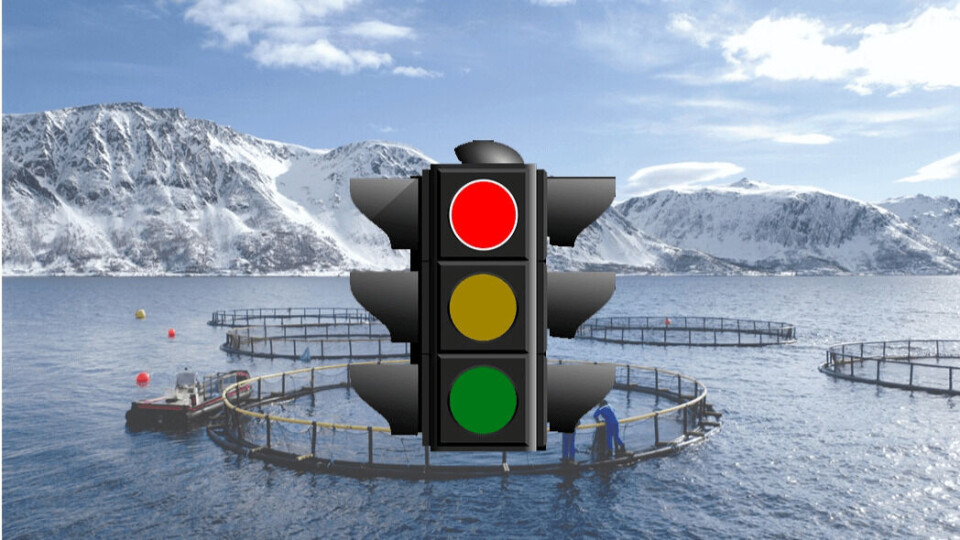
Fish farm ‘traffic light’ system must be more transparent, say experts
An international evaluation committee that includes academic experts from Scotland and Ireland has highlighted weaknesses in the scientific basis in Norway’s fish farm ‘traffic light’ system.
The traffic light system divides the country’s coast into 13 production areas, from area 1 in the south to area 13 in the far north. The areas are given a green, yellow and red traffic light designation depending on the perceived risk of sea lice-induced mortality among wild salmon. Capacity is adjusted by 6% upwards (green) or down (red). In yellow areas, capacity is frozen.
The system is based on the work of senior Norwegian scientists known as the expert group. Although fish farmers say they support the system in principle, they have questioned some of the data and methodology that the expert group has used to reach its conclusions about the impact of lice on wild fish.
Wild salmon mortality
The evaluation committee was appointed late last year by the Research Council of Norway, which was assigned the task of evaluating the scientific basis for the traffic light system by the Ministry of Trade and Industry.
The committee has now submitted a memorandum with preliminary assessments and proposals for improvements in accordance with its mandate. It will deliver the final evaluation report in November 2021.
One of the points raised by the international committee is about the estimates and calculations for mortality limits for wild salmon.
Origin of the data
“Both Taranger et al (2011, 2012) and the expert group’s report (2019) indicate that available knowledge about infection intensity and negative effect on wild salmon smolt is deficient and should be investigated further,” writes the committee.
The international committee further writes that it has not been able to trace exactly where the mortality estimates and limit values used in the traffic light system come from.
“In order for the underlying science to be more transparent, we will probably comment on the need for a more complete scientific review of the origin of the data that forms the basis for conclusions related to estimates for mortality limits for salmon lice described in Taranger et al (2011).”
A complicated process
The committee also writes that the expert group’s assessments of the traffic light system are the result of a rather complicated process in which several modelling and data analysis steps have been used.
“For reasons of transparency, the overall picture of the assessment process should be clearly described. It is our observation that the expert group lacks a clear description of this process, and as a result it is challenging to understand which data is fed into which model, or how different model results and predictions have been linked to each other.”
The committee recommends that an easier-to-understand language be used to convey the uncertainty surrounding the various assessments and modelling.
“Of particular concern is how this is communicated beyond a scientific audience to decision-makers, stakeholders and the general public,” the report states.
Court case
Earlier this year the 25 salmonid farming companies in production area 4 (PO4) challenged the science behind the traffic light system in court after the area was given a red light, leading to a 6% production cut.
The salmon farmers, who include Mowi and Lerøy, lost the case in Sogn og Fjordane District Court but have appealed the decision. The case will be heard in February.

Lawyer Trond Hatland, who represented the farmers, told Fish Farming Expert’s Norwegian sister site, Kyst.no, that his clients were happy that the evaluation has now been implemented, and that the findings of the preliminary report would be used in the appeal.
“The evaluation committee’s preliminary report shows that evaluation has been absolutely necessary,” he said.
Familiar complaints
Hatland pointed out that the committee’s recommendations correspond to points the fish farmers in PO4 had flagged as particularly problematic.
“This includes how to select and assess relevant knowledge, the professional basis for the expert group’s assumed mortality limits, quantification and dissemination of uncertainty in the various models and in the expert group’s reports and the importance of validating the effects of the red light.”
Hatland said his clients see it as particularly positive that the committee called for increased transparency in the expert group’s assessments and conclusions.
Lack of access
“The farmers have persistently pointed out a lack of access to bases and assessments - with consequences for both predictability and verifiability,” he added.
“The farmers will use the evaluation committee’s preliminary findings, and the signals about which issues must be focused on in the future, as a basis for further work on the appeal.
“In parallel, the fish farmers continue the work, together with the research communities, to obtain and disseminate knowledge for use in the traffic light system. The hope is that the expert group, the steering group and the Directorate of Fisheries will in future be more receptive to data and professionally based input, in light of the evaluation committee’s report.”























































